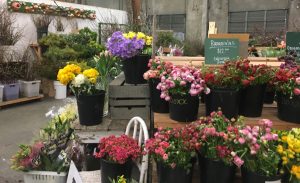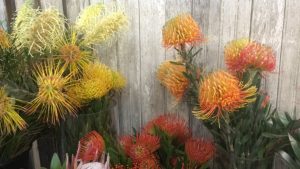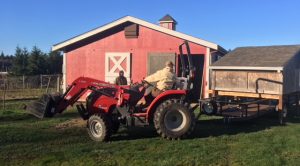SUNDAY
Sunday we woke up at 3AM to drive to Seattle for a special Valentine’s Day event at the Seattle Wholesale Growers Market Cooperative. Doug is a full member of this coop and sells all of his product at their market. During peak season (May-October), they have normal markets on Sundays, Wednesdays, and Fridays from 6AM-noon (10AM-noon the market is open to the public). During the off season (November-April), they have one market on Wednesdays, same hours. However, with it being Valentine’s Day this upcoming Wednesday, they had a special Sunday event for florists to stock up on flowers for their Valentine’s Day orders.
During the off season, they bring in a lot of product from California and Hawaii to supplement the lack of product from local growers, but all of this product needs to be salmon-safe as a base requirement to be able to sell at the market.

Photo: Allie Kuppenbender
It was pretty insane when we got there at 5AM, with people running around and trucks coming in and out of the loading docks. Immediately, we were given a tour of the new space by Diane and Denis, board members and owners of Jello Mold Farm in Mount Vernon (and my future bosses!). The space includes a storeroom, lobby, and meeting room, and is about double the size of their old space (moved locations in November 2017). They are also located a couple blocks from the other floral wholesaler of Seattle, which is good because it is now more convenient for their customers to be able to go to both in the same day.

Photo: Anika Goldner
After, we were put to work uploading trucks/vans, unpacking boxes, filling buckets, sorting flowers/greenery, and chopping stems before sending them out to the floor. We saw so many really cool and totally new to me plants. Some of these included Proteas and other Leucadendrons, Chamelaucium (wax flower), Claycina, and Moroccan Date Palm. It was really cool to see all of these unique and downright weird plants in conjunction with the more native things like English Ivy (yes someone was selling this noxious weed at the market), pussy willow, and cedar as well as the more familiar things like roses, ranunculus, and tulips.

Photo: Allie Kuppenbender
Doug was really excited by the variety of things the growers from Oregon were able to bring this early. He thinks this is good news for him as Washington will get an earlier spring too. They had a lot of Oregon-grown tulips, ranunculus, anemones, and heather.
In terms of product, they received 90 boxes worth of flowers and greenery this past Wednesday for this market and we received 150 boxes Sunday morning. All of these were unpacked and processed by us Sunday morning. All of this product came from California and Hawaii, thus not even including the actual grower-members’ product. Doug said he believes all of the California/Hawaii product will be sold Sunday or else on their normal Wednesday market on actual Valentine’s Day. The stuff that is less likely to sell is actually the grower-member stuff that’s not the tulips, ranunculus, etc.—the things like the pussy willow and cedar as it doesn’t really say “Valentine’s Day.

Photo: Anika Goldner
It was a long day—we got home at 2PM. But it was fun and I learned a lot. Plus it was really good to see Denis and Diane of Jello Mold Farm as well as the new space for the market.
MONDAY
Monday morning was rough (Anika and I were really tired from the day before), but we had a really interesting project to accomplish. We were tasked with rotating the chicken coop. When I first heard that I was incredibly skeptical, but it actually worked! A little bit sketchy at times, but we did it. Basically, we used a car jack to jacked up the coop, used 4x4s to brace it on top of the trailer, used the tractor to rotate the coop, and set it upon cinder blocks, now facing the south (and the sun).

Photo: Anika Goldner
Why rotate the chicken coop? Well, Doug has been treating it as a grow room and keeping our blueberry cuttings in it, but the window that lets light in is facing north not south (thus flipping it around would allow sunlight to help the blueberries in their rooting process). We used a car jack to hoist the coop up and suspend it on the trailer. Doug used the tractor to turn the trailer (and coop) around. We had to dig a trench for the leg clearance, but it worked! We rotated the coop so it was facing south.

Photo: Allie Kuppenbender
After rotating, we ripped off the front wall and window and part of the westside wall. We then covered that open area with extra greenhouse plastic Doug has lying around. This was to ensure additional light into the coop. Considering I was so skeptical at first that this would work, it was pretty cool to see this project from start to finish. That’s what I really like about working with Doug; he is constantly pushing my limits in terms of what I think is possible/will actually work (i.e. the garage greenhouse conversion, building a foundation for the cooler). He is willing to try pretty much anything, which really seems to pay off for him. I will definitely take that with me into the future as I am not intuitively like that at all.
Monday afternoon, we seeded. We used a new method adopted by Doug from Little Big Farm. Basically, you don’t fill the trays quite as full and seed normally, but cover the top with vermiculite or pearlite. This ensures a crust won’t form over the top, disabling water to penetrate to the seed. Floret also uses this method for seeding.
What we seeded:
- two 72s—Cerinthe, Kiwi Blue variety
- two 72s—Agastache, Pink Pop mix
- one 72—Antirrhinum, Chantilly Bronze
Also the spring crocuses began to bloom! I’m so excited for spring and all of the new blooms to come.

Photo: Allie Kuppenbender
